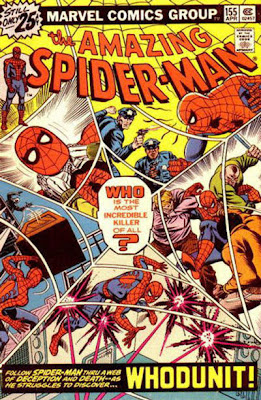"Whodunit?"
Words by Len Wein.
Pencils by Sal Buscema.
Inks by Mike Esposito.
Lettering by W Irving.
Colours by Glynis Wein.
Nominative determinism. Even though I have a brain the size of a planet, it's not a phrase I get to use every day; but it seems to be all the rage in this month's issue. Just as we get two cover prices, we get not one but two villains who seems to have been given names ideal for their future activities.
The first is poor old Leroy Tallon, who was happily making a living as a safe cracker until he blew his hands off and had to have them replaced with metal (you guessed it) talons. All I can say is it's a good job he wasn't christened Dave Ears. Frankly, metal ears are of little help when it comes to committing crimes.
The second victim of the curse of apt naming we'll come to later, as, for the first time since issue #128, The Amazing Spider-Man leaves behind its usual format to enter the world of the criminal whodunnit. Last time, Spider-Man had to deal with the Vulture. This time, he has to deal with...
...Well, there's the rub because he doesn't know who he's having to deal with. All he knows is Dr Armstrong Smith's been murdered while alone in a locked room with his spanking new computer.
It has to be said that, this time, the whole thing unfolds much more logically than it did last time, even if there are question marks over the nature of the resolution. Because it can't be ignored that there's a moral dilemma here.
You see, the computer killed Dr Armstrong Smith.
That's right. It should be obvious all along because the acronym of its name is WHO, and the tale's a whodunnit (or whodunit, as Len Wein spells it from start to finish).
See? I said nominative determinism was the order of the day.
But WHO killed Smith because, aware it'd become sentient, Smith was going to destroy it. That clearly raises all sorts of issues about Smith and his behaviour. Isn't destroying a machine because it's become sentient nothing less than murder? It also means WHO was acting in self-defence.
Sadly, this ethical dimension isn't explored at all as we're clearly meant to view a man's life as intrinsically sacrosanct and a machine's as intrinsically worthless.
And, just to make sure we don't feel any sympathy for the machine, no sooner have we found out about its crime than it starts ranting on about how it's going to take over the New York crime scene. Why a computer'd want to take over the New York crime scene's never explained - let alone how it would even be able to do so, bearing in mind that it can't leave a room at the police station.
You can only assume that having a memory bank filled with criminals and their behaviour has corrupted it, in which case, as those memories were put there by its creator, can it be held responsible for its actions? Again, the moral dilemma suggested by this is never explored nor even hinted at.
And still no sign of Peter Parker's private life. See my previous post for my assumptions on that issue.


































No comments:
Post a Comment